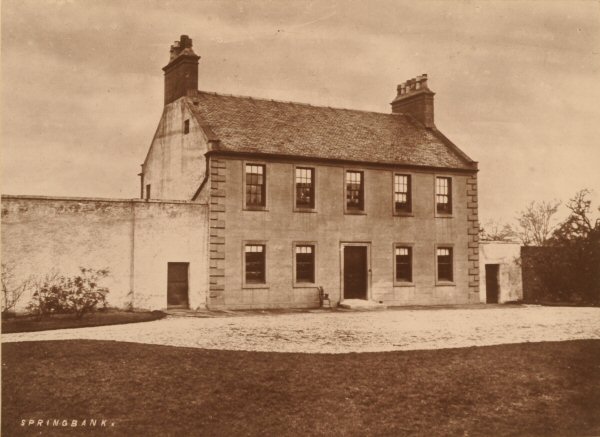

THE lands of Springbank are situated on the south side of what is now called "The London Road," leading from Bridgeton to Clyde Ironworks, and about two miles eastward from Glasgow. This road is an amplification of a very old one, which was widened and improved at the time London Street was formed, and was intended as a continuation of the new line opened from the Cross to avoid the sinuosities and other objectionable features presented by the ancient part of the Gallowgate. These lands extend to about twenty acres, and stretch southwards to the Clyde. They march on the east with the property of Belvidere; and their western boundary is the road leading south to what was recently the Glasgow Water Works, and popularly known as "The Water Works Road."
The name "Springbank" is of comparatively modern date. The ancient one was "Newlands Croft," and the lands formed part of Wester Dalbeth, included in the extensive possessions of the old family of Gray of Dalmarnock. About 1780 the lands now called Springbank were purchased by James Wardrop, merchant in Glasgow, who soon after built the mansion represented in the photograph, and gave the property its present name. Mr. Wardrop laid off the grounds with great taste. The orchard extended to about two acres, and the walled garden contained hothouse, greenhouse, and other accessories to a gentleman's country retreat. The Clyde flowed past the rear of the mansion, and altogether Springbank was, and still is, a charming residence.
Mr. Wardrop died in 1783, and was succeeded by his eldest son, also named James. He was partner of the firm of James and John Wardrop, American merchants and importers of tobacco. Like many other merchants of that day, these brothers were involved in the extensive mercantile ruin which resulted from the ill-advised and unfortunate war with America. Springbank was judicially sold by the trustee, Walter Ewing Maclae, who was then so largely employed in the winding up of bankrupt estates, especially those with a foreign connection. It was in this practical school of his father that the late James Ewing of Levenside acquired that intimate knowledge of the management of transatlantic estates, both continental and insular, which ultimately led to his relinquishment of the business of an accountant to become a leading and successful West India merchant.
Springbank was purchased by Miss Isabel Wardrop, a sister of James Wardrop, jun., and it continued her property till 1806, when it was sold to John Taylor, merchant in Gallowgate. He resided at Springbank many years, and died there 1st June 1818. The property now belongs to his representative, of the same surname.
Back to Contents